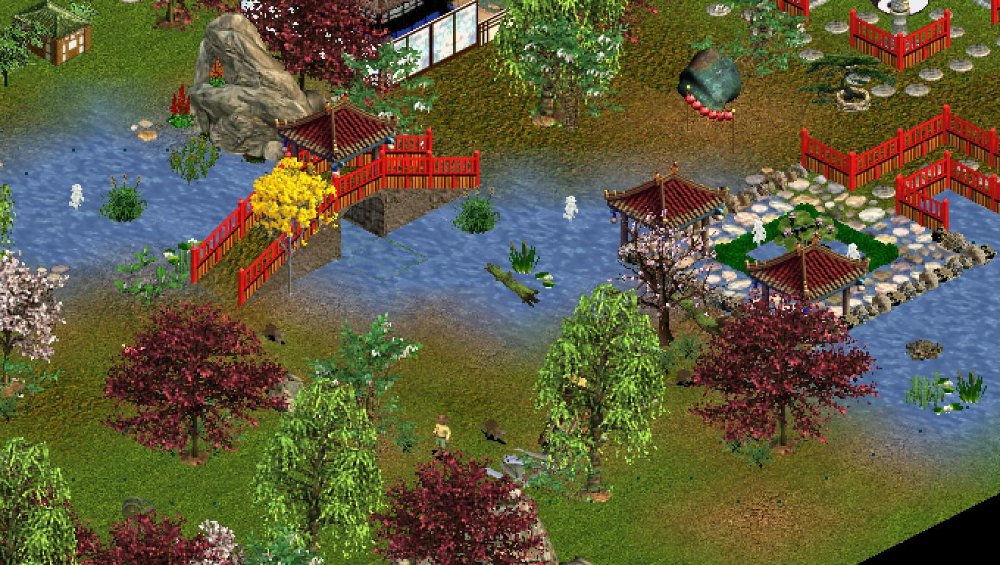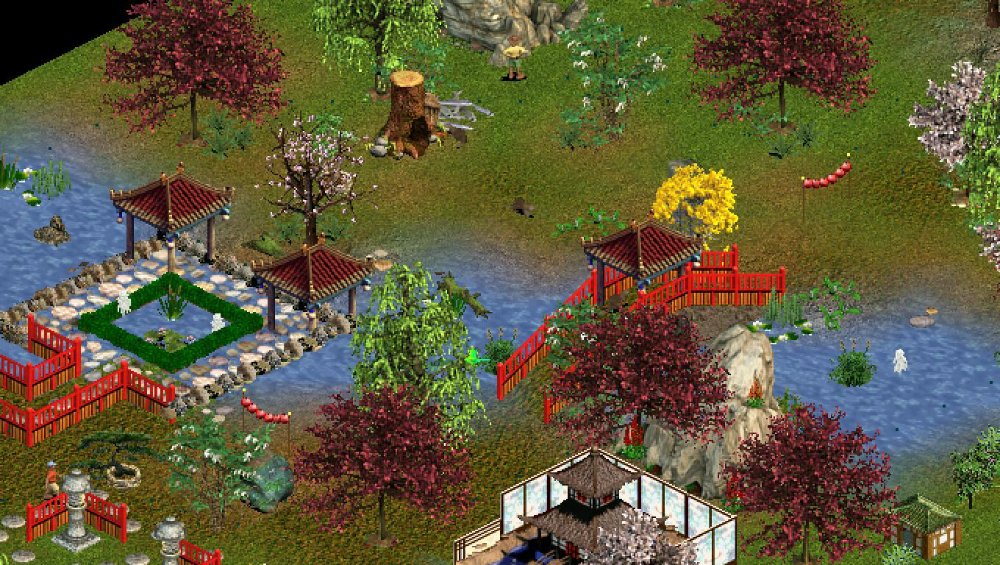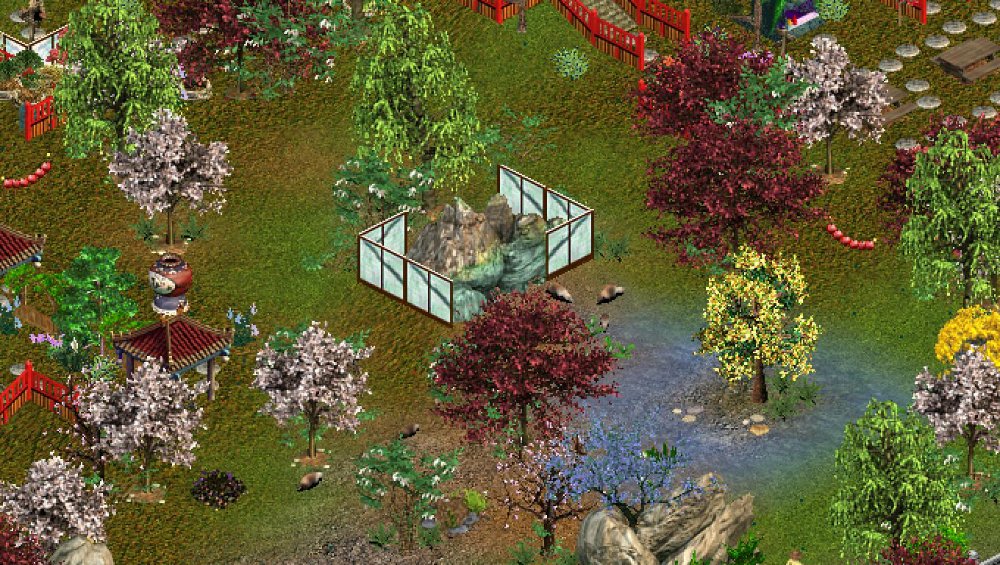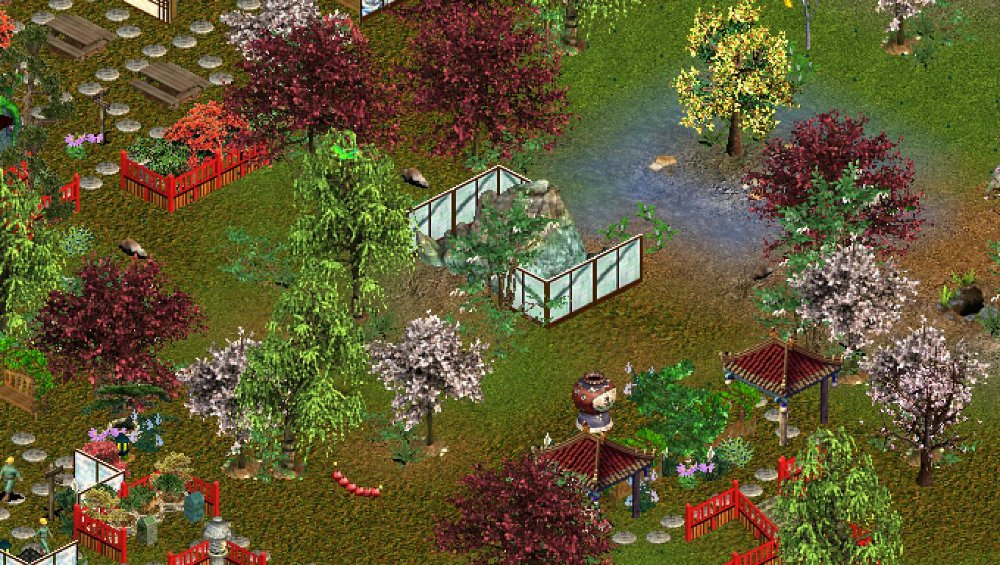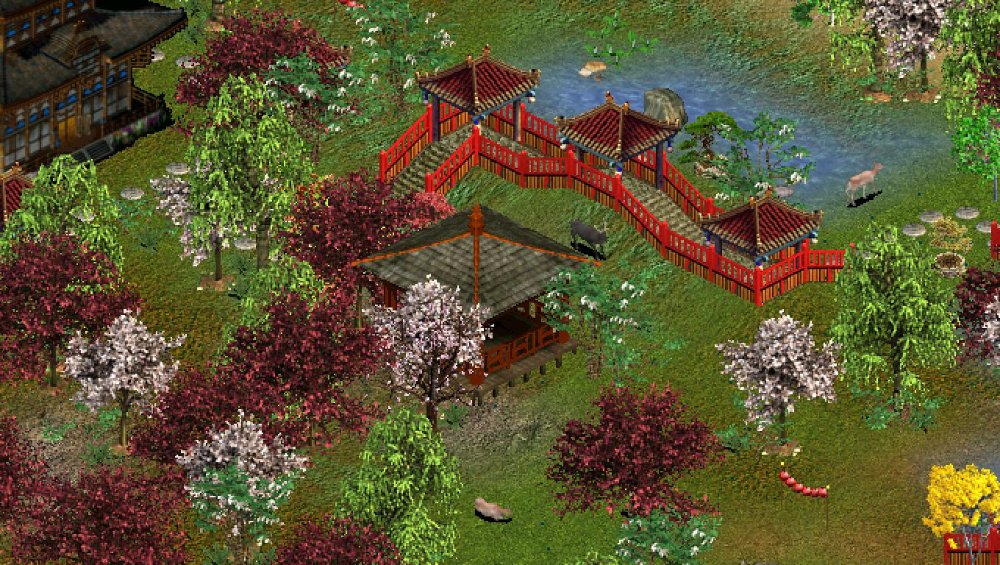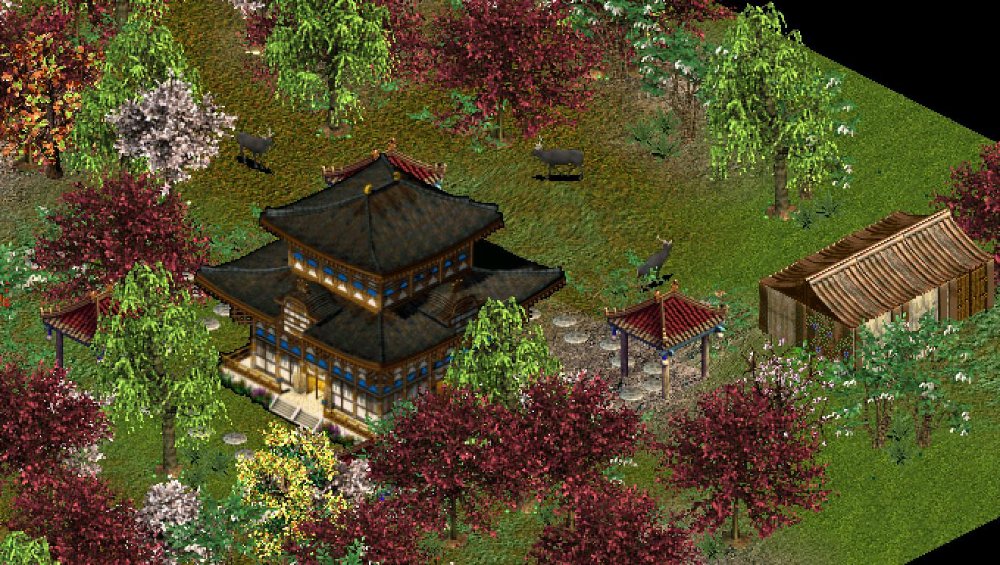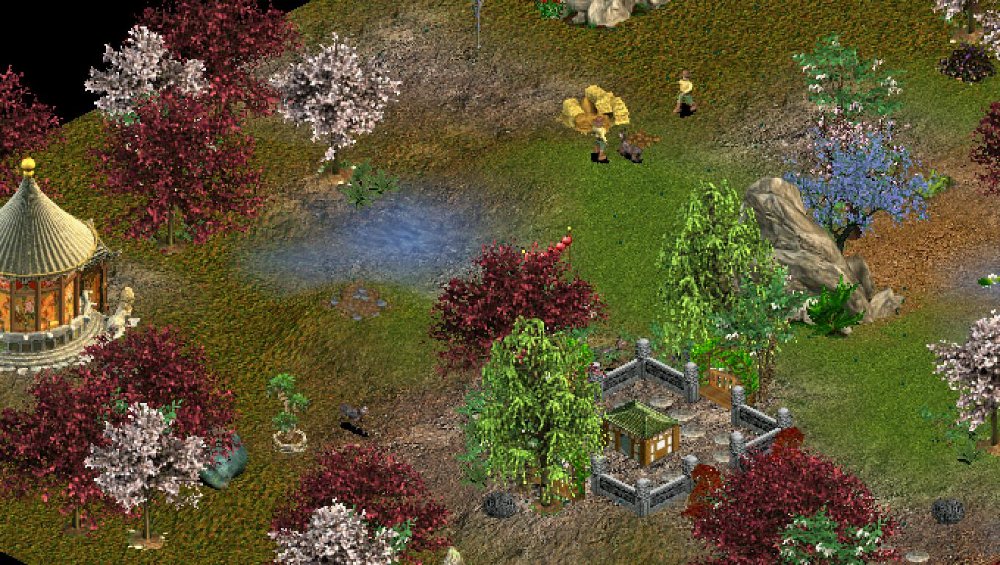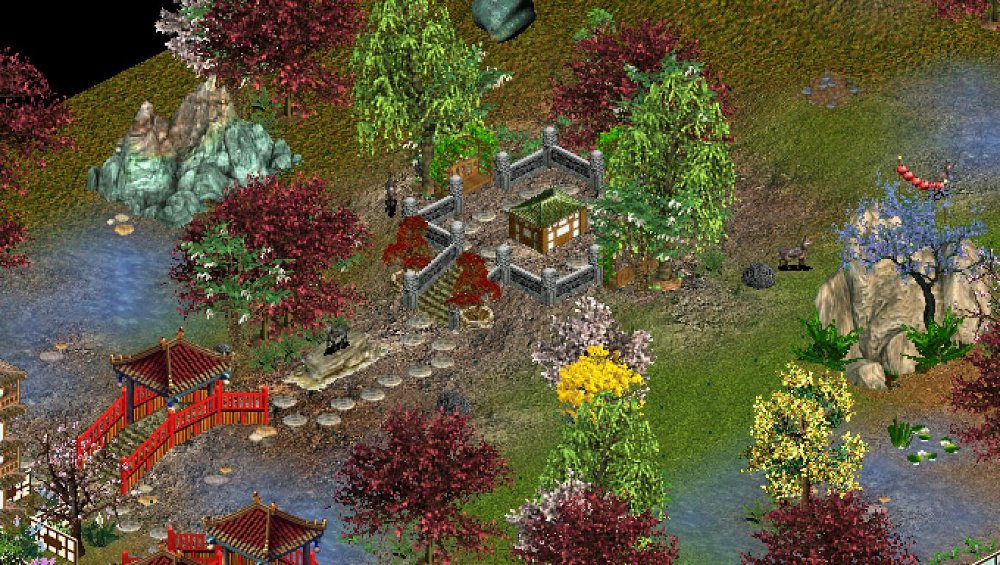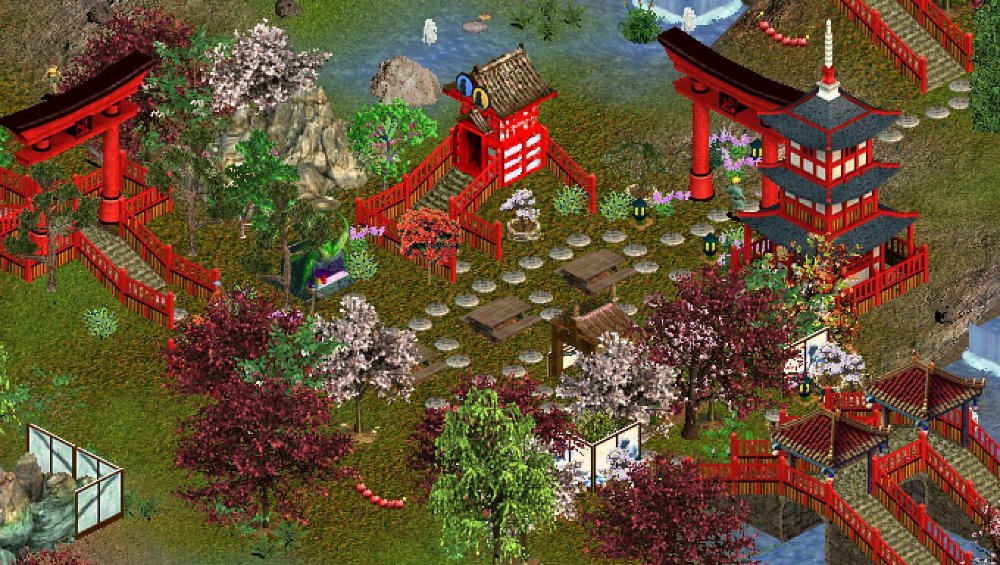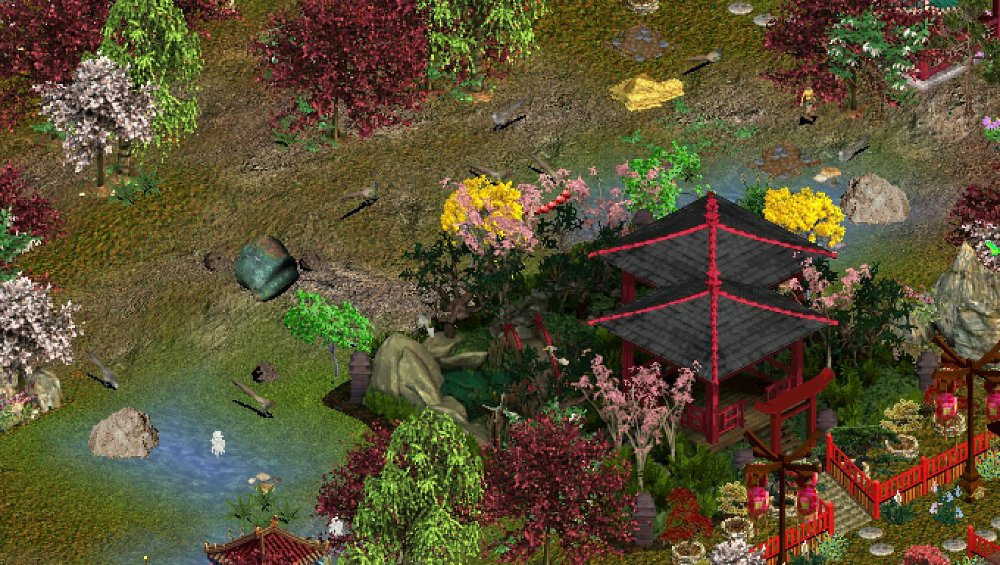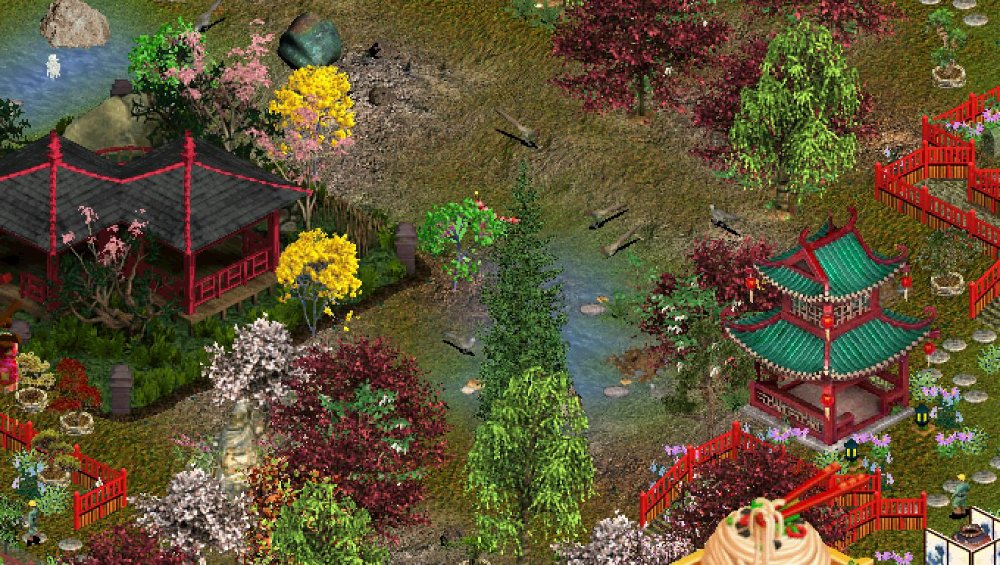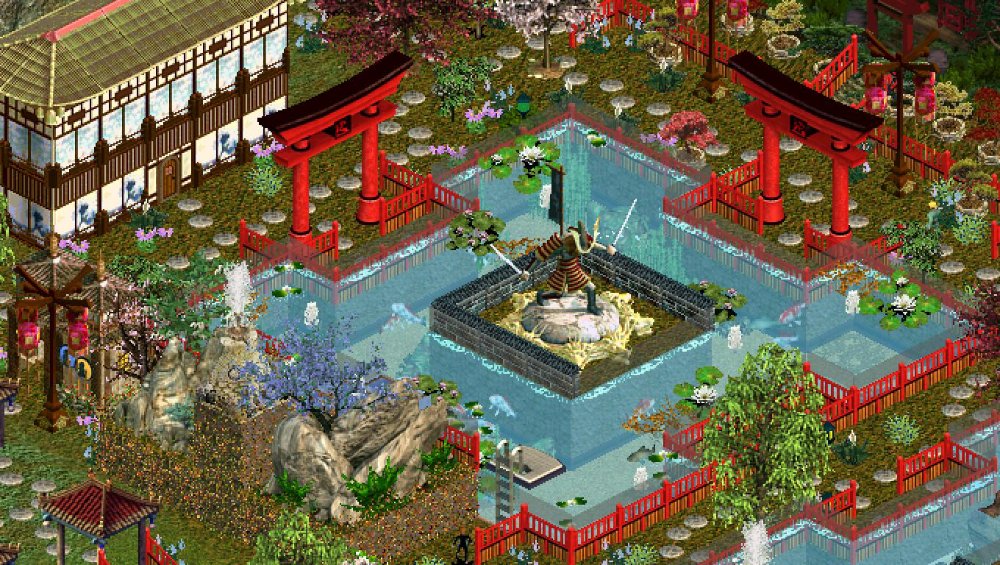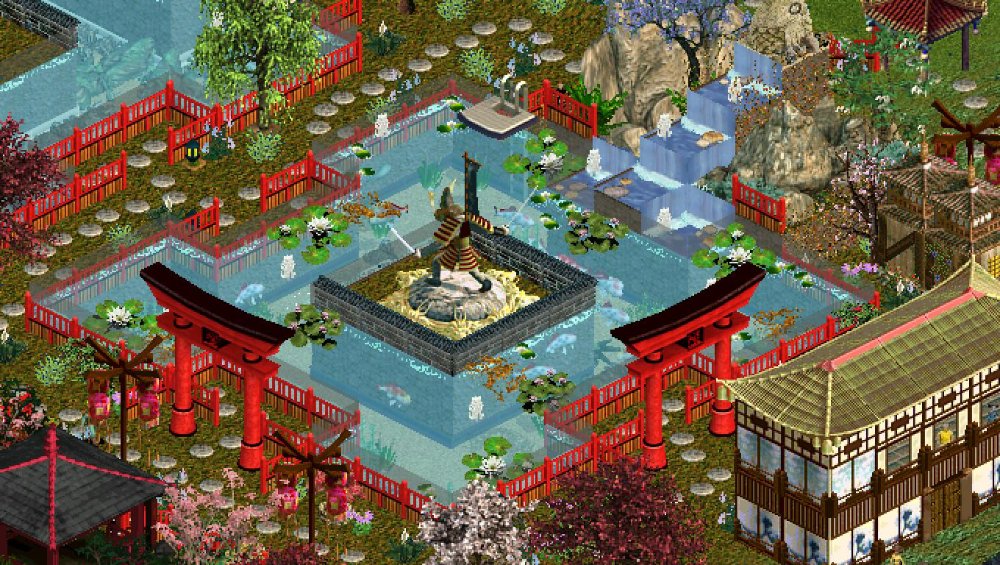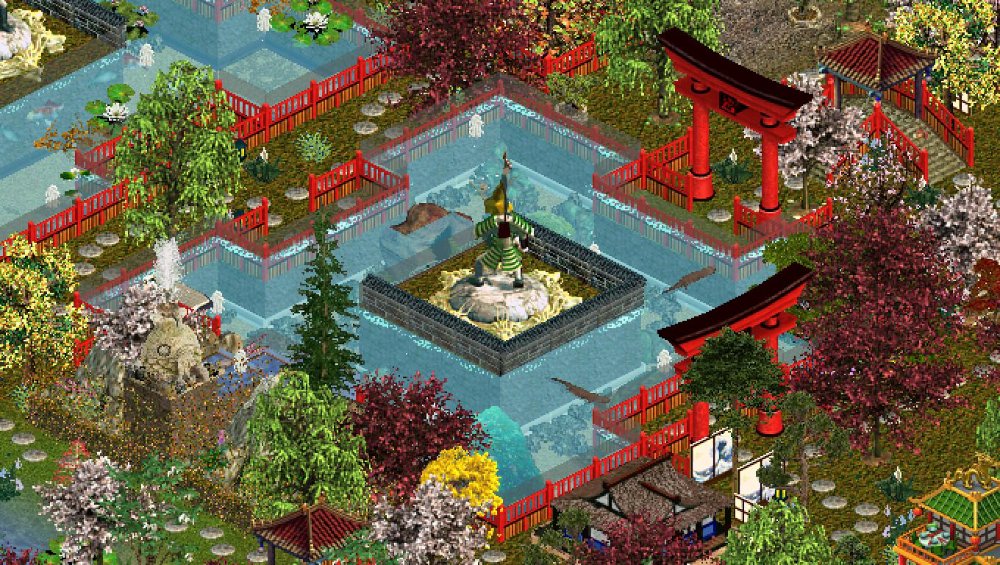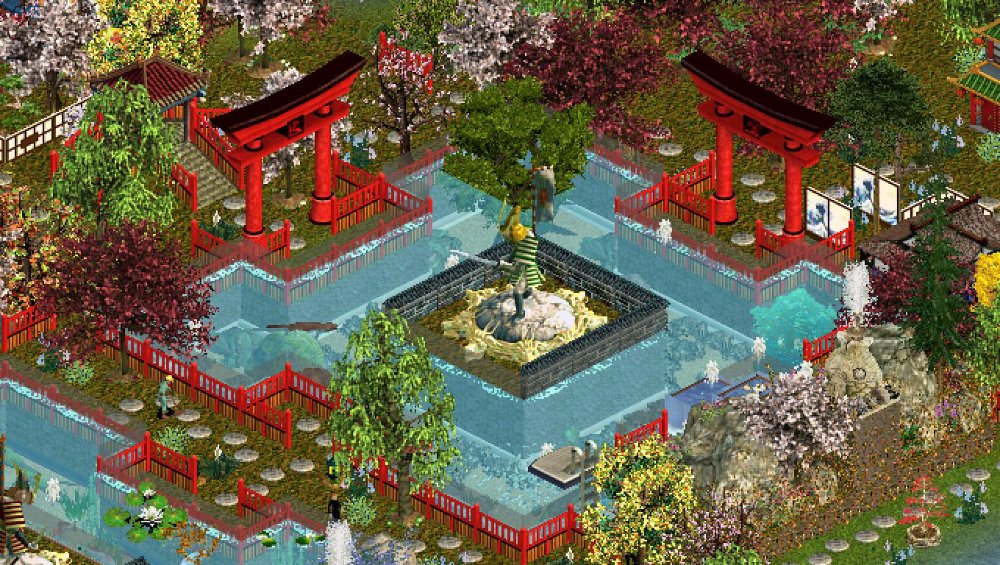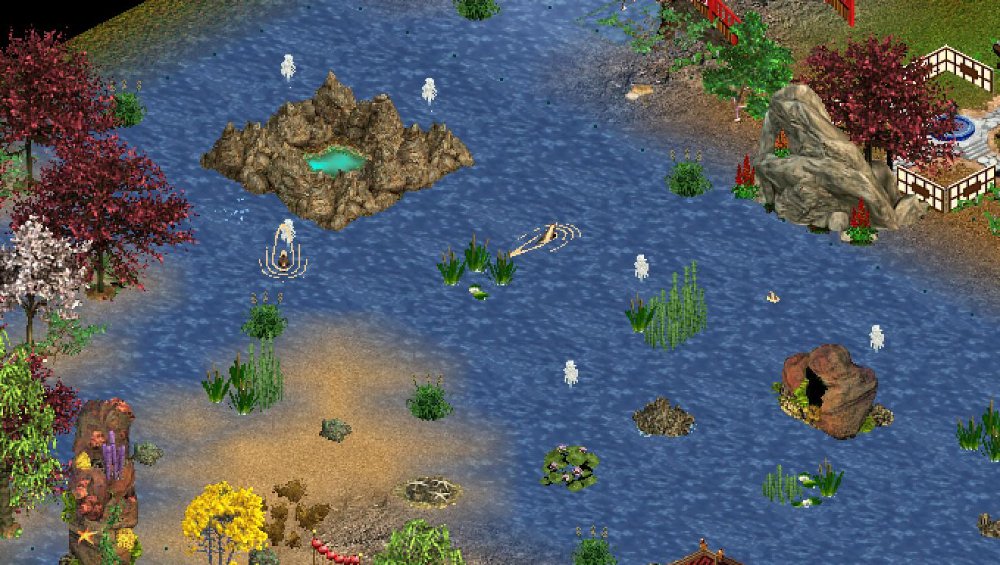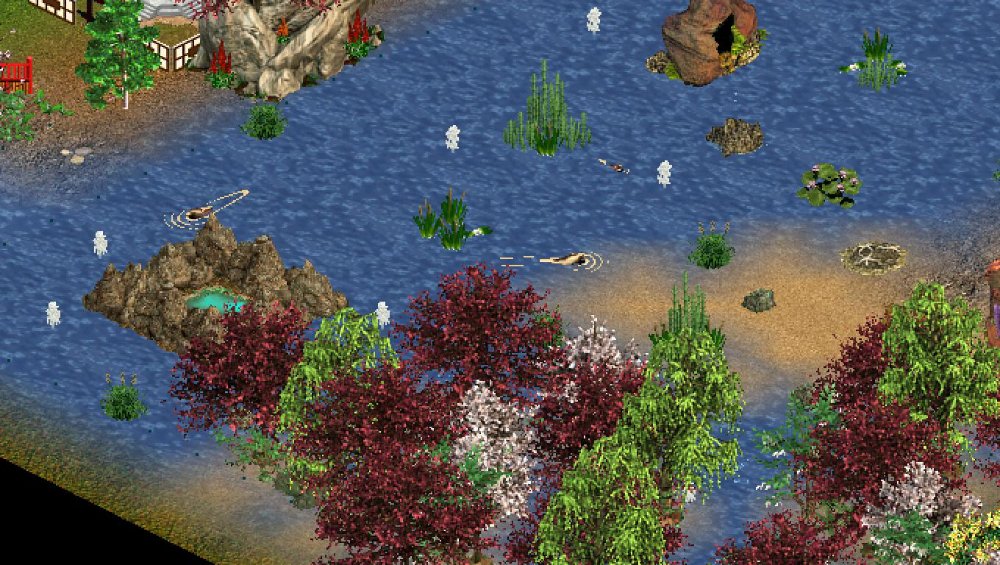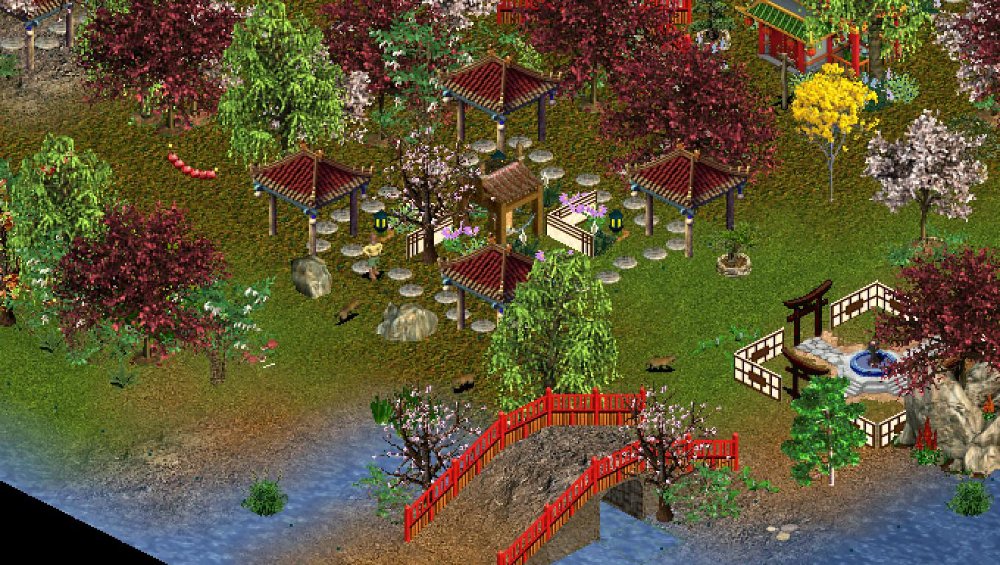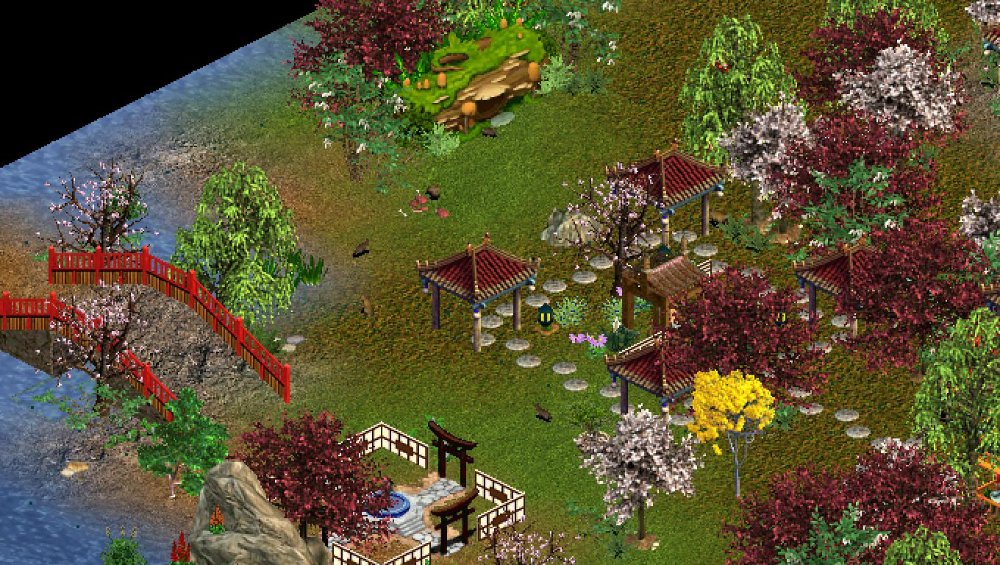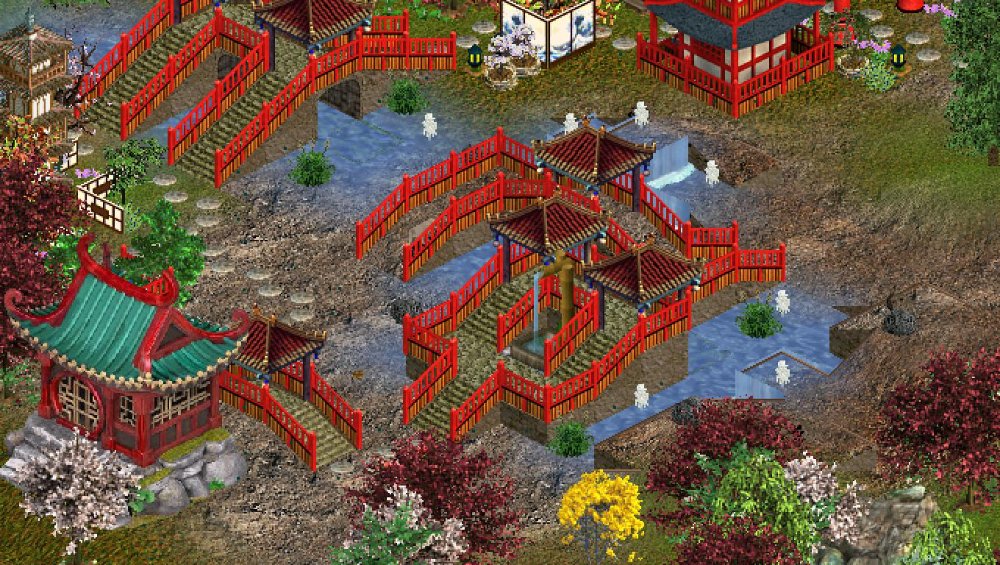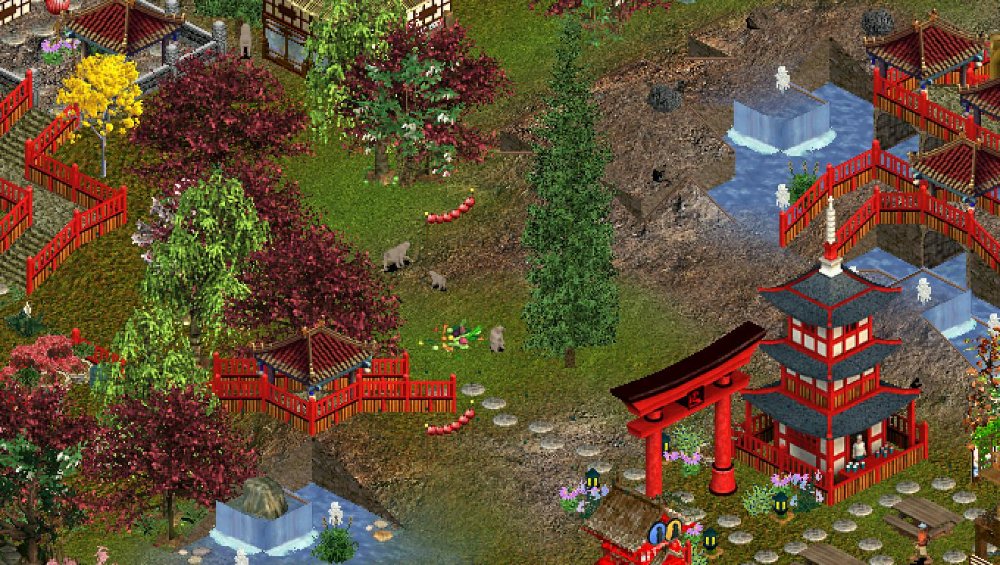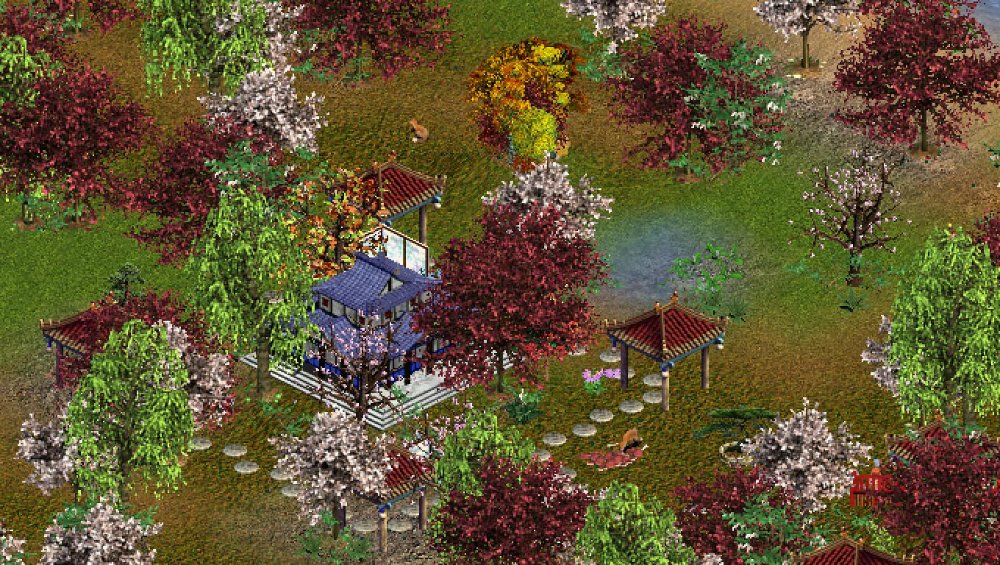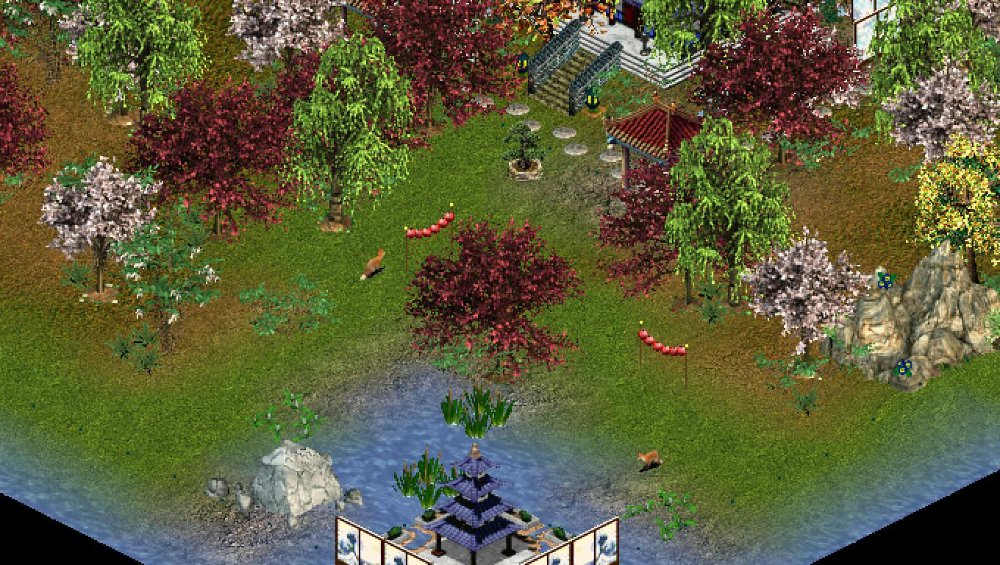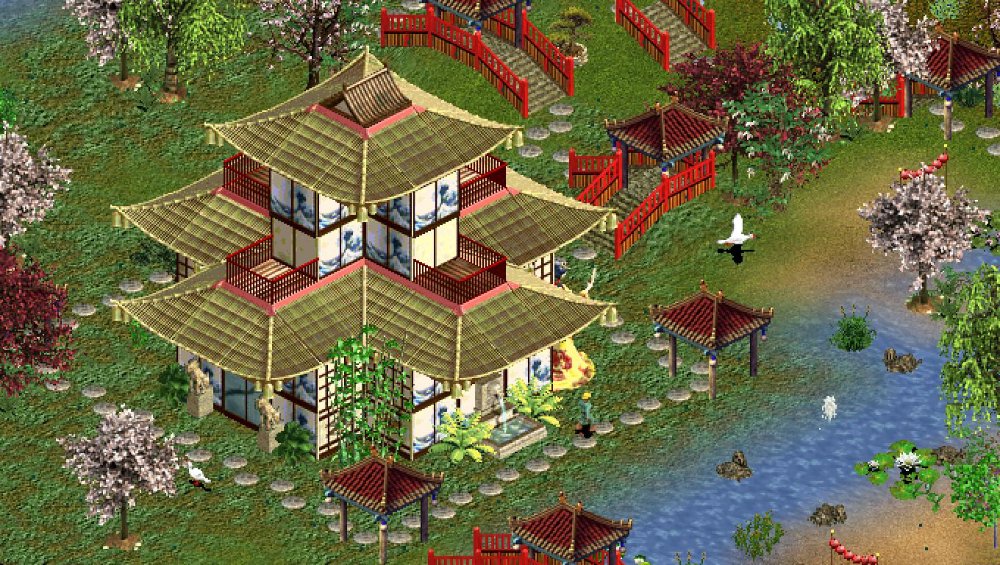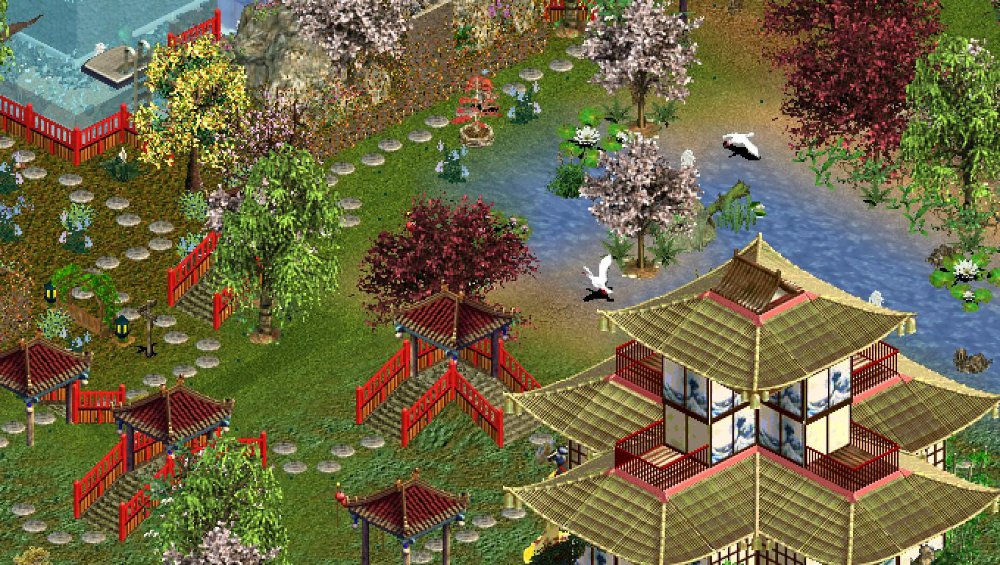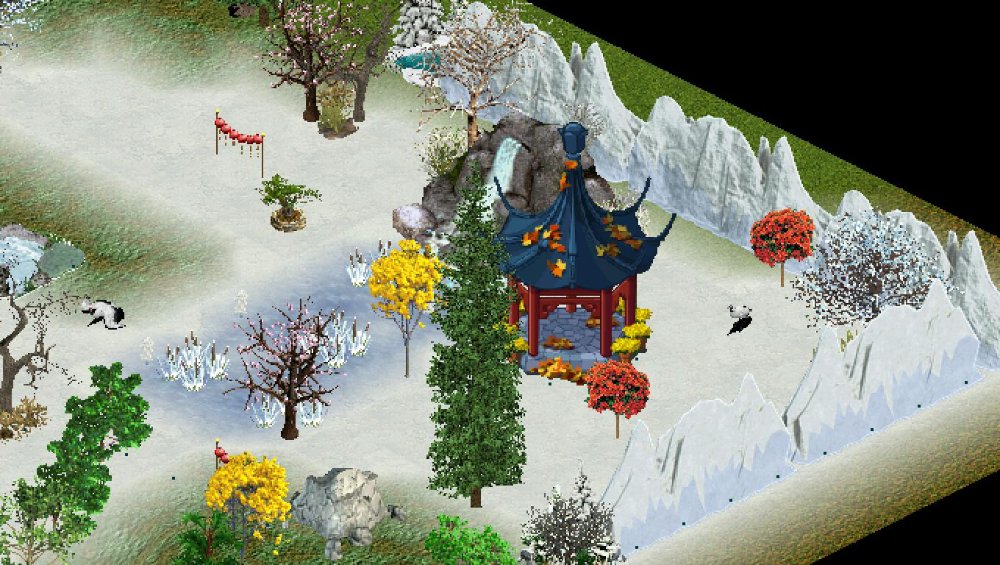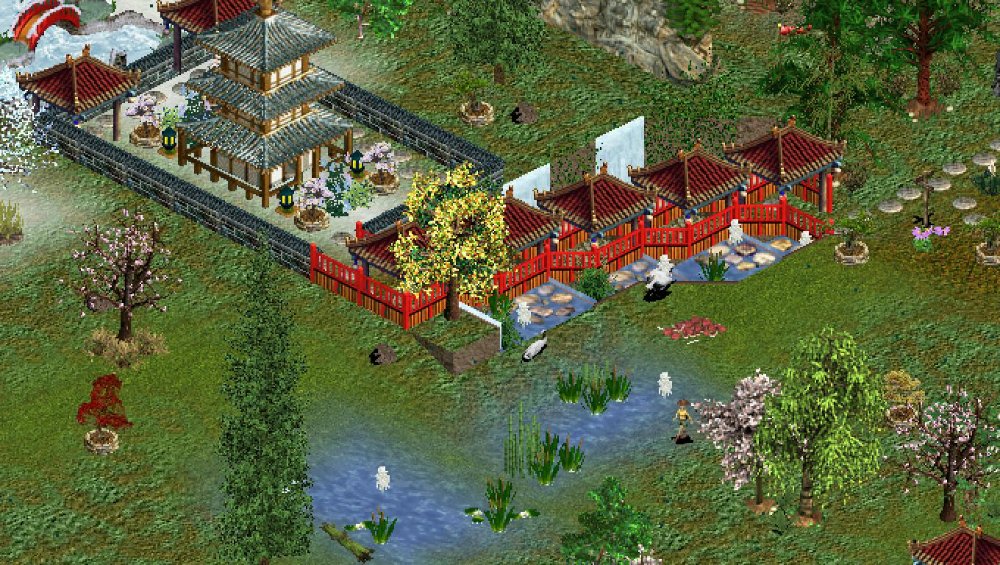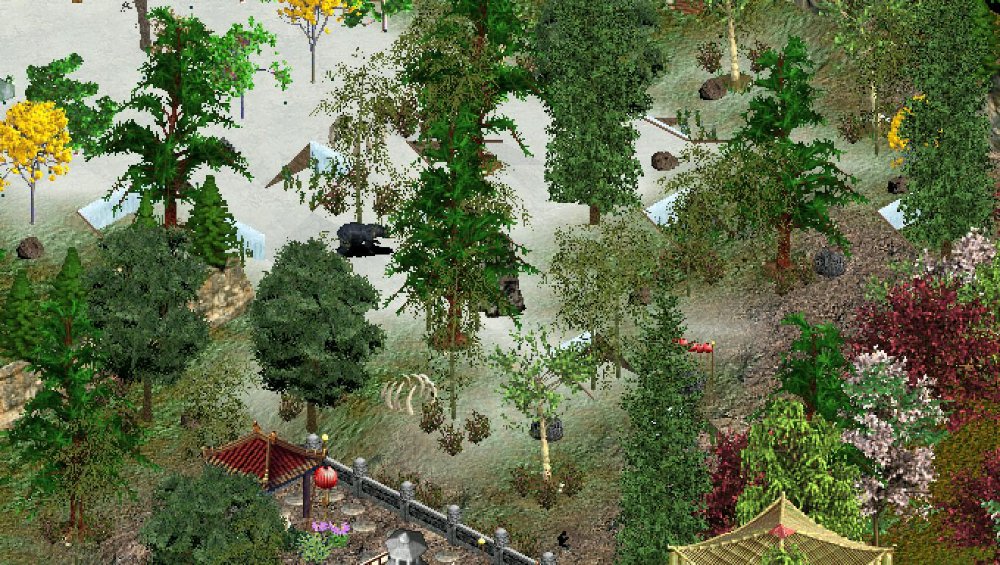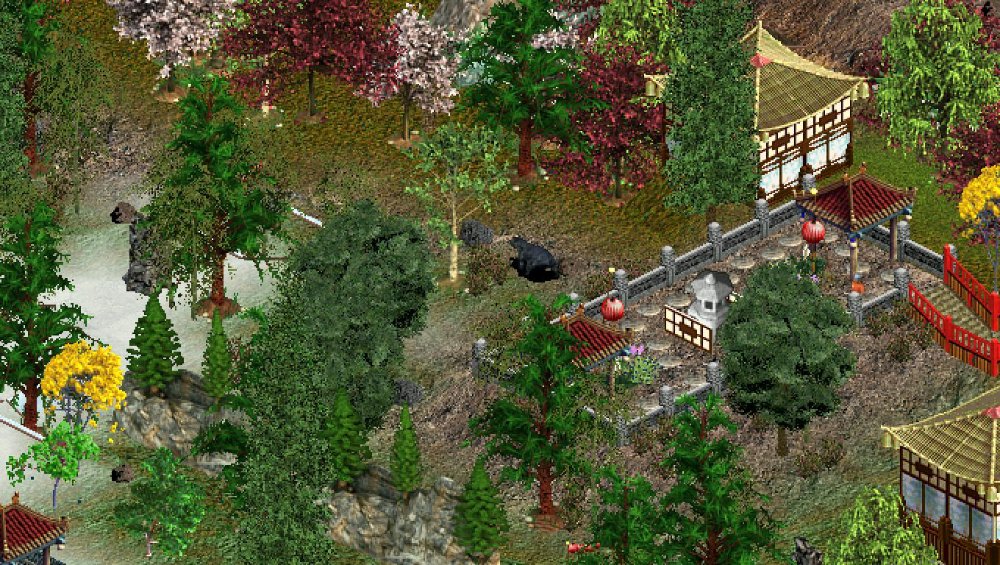Leaderboard
Popular Content
Showing content with the highest reputation on 07/12/2022 in all areas
-
City sounds left long ago. Now, there is just the breeze runing through crooked branches, sparkling water, bugs who fly around and singing birds. You know you reached the goal when the light of the lamps, like will-o-wisps awaiting there as ghosts leaning out from behind trees, appear next to the path. Right there, you notice a plaque, with the following: Welcome to the Fukkatsu (復活, Revival) Woods! Follow the lights and let yourself be driven and lost along the Fukkatsu Woods’ paths and trees, walk along the stepping stones that lead you to the dwellings of both animals and souls, find all of the hidden structures and the spirits they harbor, get drown by the sounds of its mesmerizing aura, meet the fauna that live in here and merge yourself within this forest experience until you may notice the reason of its name! Fukkatsu Woods are completely conformed by oriental tree species, including the following: - Irohamomiji (イロハモミジ, Japanese maple) Acer palmatum. - Sakuranbo (サクランボ, Cherry tree) Prunus sp. - Shidareyanagi (シダレヤナギ, Weeping willow) Salix babylonica. - Egonoki (エゴノキ, Snowbell) Styrax sp. - Akamatsu (アカマツ, Japanese pine) Pinus densiflora. - Bonsai (盆栽) trees, which include several species from around the world! Those stepping stones lead you to a small pond. Carefuly, you move your legs avoiding the water. A log floats calmly near the path, until you notice it has eyes! It's not clear if it's a staring contest or if it tries to hipnotize you. The creature starts to swim to the other side of the pond. It shakes, sprinkling water to the ground and then running to a burrow. A wet sign next to the path reads the following: Kawauso (カワウソ, Japanese river otter) Lutra nippon. † Up to date of this writing, ten years have passed since the official declaration of extinction of the Japanese otter, although all of the supposed sights and evidence that supports its survival. Initially hunted because of its fur and its liver, thought to be useful against pulmonary tuberculosis, the last nail sealing the otter’s coffin was the pollution of water that drove them to starvation, resulting in a useless effort trying to restore their population. In their better times, Japanese otters lived widely all across the Japanese archipelago. When their numbers started to decline, their range went narrow, restricted to Ehime prefecture in south Japan, where otter became the animal symbol. They had nocturnal habits, chasing fish, crabs and frogs during night, being this the possible reason of their relationship with the origin of the kappa (かっぱ), a fantastical creature that likes cucumber and dwells in rivers where lurks on humans. Now, just like kappa, otters lie just in tales. Or maybe, we don’t know, kawauso still silently go with the flow of the rivers when the night falls. Relatives from mainland say: Otters have several adaptions for water life, just like ancient cetaceans! Some of them are a membranous transparent eyelid or self-closing nostrils. But an unique feature of all otters is that they’re the only non-flying predator that do not catch their prey with their jaw. They use their paws instead! Turning around, the road drives you in front of an ancient jar. You sit in a bench and begin to watch it, so you notice some symbols and paintings on it. Suddenly, a sound comes from within! A scratch, followed by a shiver makes the urn go wobbling. Then, a nose rises from the urn hole, followed by two claws. What seems to be a long fur ball with two paws goes ot of the urn! The animal walks in circles around the urn and then hides itself in the forest. Next to the urn, you read the next: Anaguma (アナグマ, Japanese badger) Meles anakuma. It is hard to define when the Japanese word “mujina” (むじな) refers whether Japanese badger or Japanese raccoon dog. In some regions of Japan, “mujina” is the term used for Japanese badger, meanwhile “tanuki” is the word for Japanese raccoon dog or vice versa. In a consensus, “mujina” and “anaguma” (which means “hole bear”) are the names for the badger and not the raccoon dog, as is that way how people from Tokyo refers to them. Mujina is also the name of a Nihon folkloric character (“youkai”, ようかい), sometimes identified as a badger. Japanese badger is one of the four species of eurasian badgers and the smaller among them. It’s found all across the Japanese archipelago, except for the Hokkaido region, suggesting that badgers reached from mainland by the south of the island. Just like other badgers, they are omnivorous, feeding mainly on bugs and fruit. During the coldest time of the year, since November to April, Japanese badgers hibernate at their burrows, which might have up to 50 entrances for their underground tunnel system dug by generations of badger families! Despite of this fact, unlike other badger species, anaguma do not form family groups and are most solitary species. Relatives from mainland say: The weiner dog breed actual name is “dachshund” which means “badger dog” in German, due to their raising for the hunt after badgers in Europe. That resulted on their body shape and their wide flaps that halted dirt to come into their ears! You keep going across a bridge that leads you over the pond. A hut surrounded by trees calls for your attention. The wind makes the branches and leaves dancing between trees. Wait! Is a tree slowly falling? At first, you tought a branch broke and went to the ground, but it resulted to be an antler. The head of an animal went to the ground looking for grass. You moved forward to look closer, when the creature suddenly raised itself. Its ears flipped towards you. When it notices about your sudden presence, it bounces right into the woods. Below the bridge, next to the hut, between roots and leaves, a plaque stands and you may read: Shika (しか, Sika deer) Cervus nippon. In Japanese poetry, kigo (季語) are words used as a metaphor to seasons. Shika is an autumn kigo, because deer have their mating season during fall, when stags use their voices and horns seeking for a mate. During winter, their fur goes dark and, again in summer, the spots from their fur become brighter. This pattern is known as “kanoko” (かのこ) and is a kigo itself, relative to summer. This fact is quite weird, considering that shika word origin come from the old “shi” (シ) and “ka” (カ) meaning “meat” and “fur” respectively, due to the ancient Japanese people who found in this animal a source of both resources. Nowadays, their velvet antlers are still a part of Chinese medicine. It's kind of difficult to stand how many subspecies of sika deer are there due to genetic pollution, but at least 15 are well defined, with seven of them being endemic from Japan. Most of mainland subspecies are now believed to be extinct in China and Korea. They are found in evergreen forests and migrate during winter, avoiding snow. Herds are formed most by same sex individuals, except during breeding season, when stags gather a harem and expel other male shika from their territory. Relatives from mainland say: It is not strange that, even in Japan, fawns are called “bambies” like the character from the old german tale and later movie adaption. But the real species used as inspiration is roe deer (Capreolus capreolus), not that related to sika deer! A tasty smell comes from somewhere. You get into the woods again looking for it, where you find a sushi stand and a ice pagoda. You get one of each and keep walking. A rocky way guides you to a rest place where you seat again on a bench in front of a small building. It seems like the house of some kodama. As you inspect the place from your place in the bench, a noisy slurping breaks your calm. When you turn your head to the right, you find an animal stealing your drink! Astonished, you stand up quickly, leaving your items there. A second one comes, smells the sushi but goes away. It's like they aren't attracted to your food, so you take it back, but the ice is almost empty now. Next to the small building, you may read some info: Kamoshika (カモシカ, Japanese serow) Capricornis crispus. During the first half of the last century, Japanese serow populations dropped drastically because of the value of their meat, fur and antlers, until it was declared a “Special Natural Monument” by Japanese government in 1955. Since then, several surveillance programs restored the serow population, including reforestation works. In some regions, other names for this animal include “aojishi” (アオジシ), “kurashishi” (クラシシ) or even “ushioni” (うしおに) which is the name of a folkloric creature with eastern demon-like horns. It was firstly thought that they lived only in mountain regions, but when their population grew, serow reached lowland forests and even the coastal line at Shimokita Peninsula. Also, their main predator, Japanese wolf (Canis lupus hodophilax), went extinct in early 20th century, so they were able to grew in new areas. Serow are lonely animals which mark territories with the glands of their eyes. Usually, the territories don’t overlap between individuals of the same sex, only with the opposite sex. When that happens, kamoshika fight each other using their horns. Relatives from mainland say: Serow is the only wild bovid found in Japan, and is the only one among the other serow species able to bear cold weather from Japanese mountains! Unlike mainland serow, they do not migrate during cold seasons! Recently, the serow species were classified under the same genus as the gorals. During your road, you almost finished your sushi. Walking next to a tall building, you look upwards, placing your gaze in its summit. With the tips of your fingers, you thumb the tray searching that last piece, but it's not there! You then turn your head and find the empty tray. A small silhouette is runing away. You notice it has the sushi in its hand, so you go following it, until it jumps into a pond. It shrieks from the water, where a second creature stanches the food. From the side of the water, you can just laugh of them fighting for your food. When they finally eat it, you go upstairs to the lookout, where you find the metalic plaque: Saru (さる, Japanese macaque) Macaca fuscata. Be careful near these friends! It is normal that macaques attack if they find that tourists have food. This thief instinct is what makes them a trouble when human reach their environment, because macaques will steal food from fields or houses, damaging crops and stuff in the process. However, Japanese monkeys are displayed in fairytales and beliefs. They are regarded as “mountain gods” since ancient times. In local belief, it is familiar to us the so-called three wise monkeys, who stand for “see no evil, hear no evil, speak no evil”. Also known as snow monkey or “mashira” (ましら), Japanese macaque are distributed in three of the four main islands of the archipelago, including the Shimokita Peninsula, making them the northernmost non-human primate in the world because of this, in addition to the fact that no other primate lives in such a cold climate. This population in north Japan is known as northern limit monkeys and it is tought that saru can’t live as far as Hokkaido because of the warm weather even if they were able to swim that away. Relatives from mainland say: Rhesus macaque (Macaca mulatta), a close relative of the Japanese macaque, is well known by scientists! Have you ever wondered what is the blood group called “Rh factor” that may be “Rh+” or “Rh-”? Those are proteins from the surface of red blood cells described by Landsteiner & Weiner in 1937 found in rhesus macaque. “Rh” stands for “rhesus”! That is not the sound of the woods or water. It's music! Yes! It comes from another hut, bigger than that you found before. This one is also open, so you may enter, take a walk and relax yourself. There, in addition to the music played by a woman dressed with a kimono, a chant comes from somewhere. You go to the bottom of the hut, where the wind lends you some strange feathers. These are long and bright. Above the railing, a bird stands and sings loudly. It jumps away, lefting some feathers in the process. You go and crouch to pick them, but a flutter halts you. Another bird is in the place, judging you with its gaze. You stand calmly and walk again alongside the railing, when you find the plaque that lets you know: Kiji (キジ, Green pheasant) Phasianus versicolor. Selected as Japan’s National Bird, green pheasants are such a magnificent bird. There are so much proverbs and beliefs about this animal, including the superstition of this bird’s chant being a premonition of a soon earthquake. But an actual fact is that this is a high-quality edible animal. Pheasants are not truly endangered despite all of their hunting for their meat and feathers, as this activity is strongly regulated. They are not good flight birds, but great runners. Female pheasants lay half a dozen up to one whole dozen of eggs in a year, from April to July and need to be incubated for 23 to 25days, just a bit more than a chicken egg. There are four subspecies of the green pheasant distributed in Japan, except for the islands of Tsushima and Hokkaido, where common pheasants (Phasianus colchicus) were introduced. However, there were so much attempts to introduce kiji in another places, unsuccessfully, being the only stable extra-Japanese population found in Hawaii. Relatives from mainland say: Ostriches (Struthio camelus) might be the biggest extant bird in the world, but the biggest feathers belong in the pheasant family! Actual record for the longest feathers is disputed between the Vietnamese crested argus (Rheinardia ocellata) and the Reeve’s pheasant (Syrmaticus reevesii) whose tail feathers are both 1.8 meters long! When you exit the hut, some drops reach your skin. You approach to a pond you didn't notice before. A giant samurai stands in the center. From the back, a waterfall and a fountain fill the pond. When you're close enough, a bunch of colorful fishes reach you from the bottom of the pond. You've seen fishes like these but at least 20 times smaller! But, among them, you find some that are different. At your left, you have a plaque with information, as usual, but on the other side you have another one. You read them both, so you know about the two species found in the pond: Nishikigoi (ニシキゴイ, Koi carp) Cyprinus rubrofuscus var. “koi”. Most of us are sure familiar to these colorful fishes that some people have at their homes. At some parks, ponds have even introduced koi carps, in addition to ornament, because these fishes feed on mosquito larvae. Breeds are numerous and have different names according to colors and patterns. Briefly, colored koi other than black, are called “irogoi” (イロゴイ), and specially the red koi are called “higoi” (ヒゴイ). Whereas black ones are then called “magoi” (マゴイ). In example, we can talk about breeds like “kouhaku” (こうはく) which has white skin with red patches, and so on. The wild variety, Amur carp, is a picky fish with sensitive requirements. On the other hand, koi breeds are tougher and versatile. They prefer the cold-water bodies, but when they are released on the wild, their coloration gets lost with the passing of generations and returning to the pigmentation of the Amur wild carp. As koi feed on bottom substrate, their presence in the wild results in the turbidity of water bodies, making them unsuitable for the develop of plants or even for cattle. May us take this pond as an example for the responsible care of nishikigoi. Relatives from mainland say: Unlike goldfish (Carassius auratus), that were bred on mainland China, the koi carps’ origin is recorded in Niigata prefecture where rice workers caught carps with brighter colors. Koi main distinguishable feature are their mustache-like whiskers! You turn around and read the second plaque. The floor is slippery, so you crouch carefuly: Gengoroubuna (ゲンゴロウブナ, Crucian carp) Carassius cuvieri. Closely related to goldfish (Carassius auratus), crucian carps are bred as a substitute of other fish species like nigorobuna (ニゴロブナ, Carassius buergeri grandolicus) and the farmed variety is known as “kawachibuna” (カワチブナ). There is also another variety with an unusual body length, known as “herabuna” (ヘラブナ) that feeds most on phytoplankton, resulting in the development of starch-based bait, like those made from mashed potatoes or udon pasta. Wild crucian carp is endemic of Lake Biwa, the biggest water body in Japan, and the only river that flows out from it, Yodo River. However, it has been introduced across the whole Japan island. The farm variations of crucian carp are widely distributed in Japanese water bodies, but the wild gengoroubuna is threatened by the exotic introduces species at Lake Biwa that feed on their larvae, like the largemouth bass (Micropterus salmoides). Relatives from mainland say: Everybody loves sushi! Of course! But the consumption of raw fish resulted in the adaption of parasites that infect fish and may reach human hosts! Most of them are flukes like Clonorchis sinensis, but farmers manage to keep them away of their ponds. A second waterfall stands on the other side of the path. You notice something weird about this one. The fish's pond is full of aquatic plants, but this one is mostly full of rocks. You notice a second samurai warrior facing the first one. Of course! It has sense! They're like two contendants ready to fight each other! You peek into the water of this second pond, intrigued about what kind of fish dwells in this strange exhibit, but you find none. Your nose almost touches the surface, looking for something, when an enormous creature creeps right in front of you down there. You can barely see it, as it merges with its rocky enviroment. It slides and then gets lost from your sight. Your body goes erect again, and you find the wet slimy plaque: Ousanshouwo (オオサンショウウオ, Japanese giant salamander) Andrias japonicus. This amphibian has also a less known and older name: “Hanzaki” (ハンザキ) which is a reference about the fact of this animal being able to be split in half and still survive because of its enormous mouth. We now know that this is not truth, but the origin of this seems to be also a modification of the even more ancient name “Hajikamiio” (はじかみいを). In the past, in some regions the salamanders were hunt as a food source, but the restrictions after this came in the middle of last century. Anyways, their main threat is the building of dams and the hybridization with the introduced Chinese giant salamander (Andrias davidianus) which is also a protected species, making this situation quite difficult to deal with. Salamanders are fully aquatic and nocturnal, so they rest in underwater burrows. They build their nests during June and July, so the females lay eggs in late August and September. Females may lay up to 500 eggs and they hatch after 50 days. Their natural range is limited to southwestern Japan rivers, mostly the Wara River and the Komami River, where the ousanshouwo have their lodging. Relatives from mainland say: As the name suggests, giant salamanders from the genus Andrias are the biggest extant amphibians in the world! South China giant salamander (Andrias sligoi) biggest recorded specimen was 1.8 meters long! If it wasn't enough water, the road leads you right into the sea! Two statues welcomes you to this spot. The sea waves come from so far, hiding whatever inhabits this side of the park. You look into the water and the sand, when a creature emerges to the sand. It slaps itself with its flippers. It seems to greet you, so it gets your attention. Into the water, a cave that swallows every wave that hits it. A yell comes from its entrance and the animal turns its head in that direction. A second shout indicates that another animal is in there. Its face emerges and keeps calling for its partner. From the sand, the animal starts jumping and then it gets into the water until reaching the cave and hiding itself inside. A sandy plaque, next to the statues, stands for you: Ashika (アシカ, Japanese sea lion) Zalophus japonicus. † Along this animal whole story, it received several names. Most of them included the word “umi” (ウミ) which means “sea” in Japanese. Sea lion population falldown, just like that of the sea itself, started at the beginning of the last century. Fishermen hunted and extermined them out due to the oil found under their coats. The concerns for their surveillance came too late and then their homes went disturbed by the submarine war that came after that, being the last sea lion from the Japan sea officially sighted as far as during the 70s decade. Despite of this, some people still believe that these pinnipeds still hide at some place there where the horizon merges with the sea waves. Japanese sea lions swam the waters from Japan up far north reaching Kamchatka peninsula, where supposed recent sights are suspected to be actually from Steller’s sea lion (Eumetopias jubatus). It is known that these sea lions preferred to take rest in sandy caves instead of rocks or islets. Are they actually extinct and lost to the world, or do ashika still lay at the caves of the Pacific Ocean coasts? Relatives from mainland say: Do you want to distinguish sea lions at the sea during your next beach journey? Look after their ears! Pinnipeds like sea lions have ears, opposite to phocids like seals, who lack them. Also, sea lions may erect their bodies but seals do not! A chime gets into your ears. The sound wants you to find its source back in the woods. You resume your walking into the forest, when you find a bell standing there. Who's making it sound? You turn around looking for someone, when the bell chimes again by itself! Is it a mechanical device making the bell sound? With caution, you inspect the place, when you notice the cause of the sound. A small friend is hiden below the tent, hitting the bell from there! It has its hands in its snout, looking like if it was holding its laugh. After few seconds, it puts its hands again on the bell, making it sound again. The animal then leaves its place and starts walking right into a log, where it sits right in the entrance. Who of you two is having fun about the other? Behind the bell, between mushrooms, the plaque awaits for you: Tanuki (たぬき, Japanese raccoon dog) Nyctereutes viverrinus. This animal is a whole icon of the Japanese culture. It has several folkloric depictions and is the main character from proverbs and tales. The mythical depiction of raccoon dogs is called “bakedanuki” (ばけだぬき) and many special skills are imputed to its image, including shapeshifting, human disguise and possession, with lots of tales across all Japan about these animals masquerading as humans and even other fantastical beasts. These are ancient depictions, but you sure remember a videogame character that has a raccoon like suit which gives it the ability of flight. A fact about this animal that may be the origin of all the folklore around it is that raccoon dogs undergo thanatosis, when animals mimic their own death. But this ability doesn’t exclude them of modern real threats like traffic accidents, artificial feeding and diseases like distemper. They form family groups at burrows, but they may use badger or fox burrows, even underfloor or rooms if human settlements are close to their natural niche. Tanuki are not endangered species, but as seen in this park, most species were not until it was too late. Relatives from mainland say: Despite its name, raccoon dogs are closer to foxes! Actual raccoons (Procyon lotor) were introduced to Japan from North America. Raccoons’ thumbs allow them to open closed containers and even doors! Someone is lurking from the shadows. You feel its gaze over you. It suddenly flees, shaking the leaves. It's not the same animal like the one you've just seen. You follow its shape across the woods, reaching a small house where many of them are just there looking at you in complete silence. With your figure standing there, it is almost a perfect circle formation. The animals start looking each other. Their noses leap, their ears bend. Even one of them yawns. Almost at the same time, they stand and break formation, going to their own bussiness, except for one who is still there. It even comes closer an lets you pat its forehead. Next to the house, lighted by a lamp, the plaque with information is found. Now, you're sitting on the path with the animal next to you as you read the text: Hondogitsune (ホンドギツネ, Japanese red fox) Vulpes vulpes japonica. Talking about foxes is some controversial topic. In Japan, as in the world, foxes have been related both to fortune and disgrace. The image of the fox is known as “kitsune” (きつね) by Japanese people, and is the depiction of a mischievous creature able to disguise as human, often associated to rice fields and rice deity Inari. The truth is that foxes have, deliberately or not, been introduced in several points of the world and are a threat for local wildlife in some places, like Australia. Japanese foxes are distributed through islands of Honshu, Kyushu & Shikoku. They live in forests and are pretty territorial, but sometimes they approach to human settlements where they may steal corn, chicken or garbage in their search for food. It’s a distinct subspecies of red fox that the one found in Hokkaido, the kitakitsune (キタキツネ, Vulpes vulpes schrencki), which is slightly bigger. A well-known habit of them is burrow digging, but sometimes hondogitsune take forlorn badger burrows for their cubs after breeding season, which takes place from December to February. Relatives from mainland say: Foxes are the most successful wild canine species! They exist just in the northern hemisphere, but they are also adaptable to several environments, since forests or prairies to steppes and tundra! There are even red foxes coexisting with arctic foxes as far north as Alaska! Thirst remains. So, when you find the Geisha's Tea House, you're delighted. You hurry to get in and find a kotatsu where you may seat and have a nice drink. In your place, a shriek come from the other side of the wall. A bird is in the roof outside, but you can only see its shadow on the paper wall. A second one lands there after some time. They seem to be curious about you and your drink. This time, you won't get your drink stealt even if they try, so they limit themselves in just watching. Several minutes later, you stand up and exit the building. When you walk across the door, you listen the shriek again. The birds are in the border of the roof. You walk away from there, with the birds standing still. You find the plaque next to the Tea House: Toki (トキ, Japanese crested ibis) Nipponia nippon. Actual ibises found in Japan are not actual from Japan. How can this be possible? Last Japanese ibis died in 2003. Japanese population of ibis were reintroduced from China back in 2008. Original birds were hunted since ancient times due to their feathers and meat that was edible and medicinal. Also, most individuals died due to pesticide poisoning. Ibises’ population went down at the second half of the 20th century, when organomercurials and organochlorides began to be used in Japan. At first, this was a goal in the persecution on ibis, who was a pestfowl for crops, but the efforts on their restoration since 1993 resulted on the releasing in nature of 10 birds, being the first time that ibises flew Japanese skies since 1981. In January 11th from that year, in Sado Island, the last five wild ibises were transferred to captivity in Sado Toki Conservation Center, turning then the only wild populations, the ones found at Shaanxi in China. Before that, the original ibis’ distribution in Japan was from South Hokkaido to South Honshu islands. After their reintroduction, they’re only found in Sado City. When there is no breeding season, ibises behave as guild birds with groups up to dozens of individuals. In January, they undergo a unique feather color change from white to gray. Then, the breeding season starts and ibises behave most monogamous. We’re still looking forward toki restoration and there is much to do so. Relatives from mainland say: Ibises are worldwide known since ancient times. Actually the origin of their name soars to Egyptian culture, when there was a deity with an ibis head known as Thot, god of wisdom and medicine! In Saqqara, archaeologists have found more than a million mummified African sacred ibises (Threskiornis aethiopicus)! Your shoulders almost touch your ears as you start shiver. In the coldest side of the forest, you climb until you find a frozen pond. On the top of it, a massive bird stands. It is beautiful! It is like it was searching fish for feeding in the pond, peeking with the beak trying to thaw out the ice. It opens wide its wings and takes on flight, launching a bunch of snow in the air. The cold snowdust coats your clothes on white. With the sight, you follow the bird that goes across the snow, almost touching the ground. You find the plaque covered in snow. In order to read, you have to remove the white covering: Tanchou (タンチョウ, Red crowned crane) Grus japonensis. Since ancient times, cranes have been regarded as sacred birds due to their majestic profile. Crowned cranes garnish lots of stuff like pottery, mirrors, swords, paintings, drawings and even buildings, besides being also a motif in poetry. They are an old symbol of longevity and there are beliefs of cranes able to reach 1,000 years of age. There are also documents about this bird as medicinal and edible, but not that good or tasty. A curious point about this bird is that is not only found in Japan. There are also populations of red-crowned crane that dwell in mainland like China or Korea, but these populations migrate during winter. The only one population that stays the whole year in the same place is the Japanese one found in Hokkaido, where they are adapted to salt marshes, with which foliage they build their nests. From February to April, tanchou lay one or two eggs that are incubated by both male and female until they hatch after 31 to 36 days. Relatives from mainland say: Despite this bird’s name, red-crowned crane is not closely related to African crowned cranes from the genus Balearica. Instead, they are close to common crane (Grus grus) which has also depictions from ancient Japan as a lucky charm! You're tired! You don't end going down the stairs when you notice that you have to go up again! The rocky balcony is surounded by a low wall. On the other side, a dense forest hides a secret. On the wall, you find claw marks and blows. You had no trouble with the inhabitants of the woods, but this one afraids you a bit. You search for the plaque, unsuccessfully. A massive beast arise from the other side of the wall and you freeze yourself in time. You have no response in this situation. It seems that it's going to swoop against you, when a second figure appearse next to you. - Hey! - says a man standing there - Haven't you had your lunch yet? Go eat and stop bothering guests! The creature puts on his four legs and goes to a building next to the balcony, where it gets into a door. - Apologize it, then - says the mysterious fellow -. It's not aggresive, but when it's hungry, it likes to harass people. If you wanna meet it closer and safely, you may get into that building. It's the Fukkatsu Woods Research Station. You thank the man and start walking. As you go there, he notices he didn't introduced himself. "Call me Luca" says he. Next to the door of the research building, you find the plaque: Tsukinowaguma (ツキノワグマ, Moon bear) Ursus thibetanus. In Japan, there is an ancient legend about a character named Kintaro who wrestled a bear once. In that tale, the bear is brown, but there are no brown bears in Japan, just black bears. It seems that bears still fight against humans not just in the Nihon Archipelago, since there is a whole Asian black market for the bile and skin of black bears despite being forbidden. Several Japanese populations went extinct because of that and because they damaged crops, cattle and beekeeping. Bears, often protected, sometimes just poached, are under surveillance of laws from many countries, not just Japan, also China, Russia and India. Japanese subspecies of moon bear (Ursus thibetanus japonicus) inhabits Honshu and Shikoku islands, being extinct in Kyushu Island, Ehime and Kagawa prefectures. Unlike the American black bear (Ursus americanus), the main feature that distinguishes moon bear is a white triangular patch on its chest. In summer, they are found at 2,000 meters of altitude, but they go to lower places and hibernate during winter. It has an omnivorous diet, with a notorious tendency for fruits. Since the extinction of Japanese wolves (Canis lupus hodophilax), tsukinowaguma is the main predator in the Nihon Archipelago. Relatives from mainland say: Almost all bears are omnivorous. Polar bear (Ursus maritimus) is the only most meat eater and giant panda (Ailuropoda melanoleuca) feeds mainly on bamboo sprouts! And despite its name, red panda (Ailurus fulgens) is most related to weasels or skunks than bears! You get into the Fukkatsu Woods Research Station and start listening to the staff. They introduce you to Tsukuyomi the bear, named after the shinto moon deity. He's actually friendly and even let you hug it! At this point, you have already seen the whole Fukkatsu Woods. Did you meet the spirits that dwell in there? Do yo now understand the meaning of its name?2 points
-
1 point
-
1 point
-
1 point
-
1 point
-
1 point
-
1 point
-
1 point
-
1 point
-
1 point
-
1 point
-
1 point






